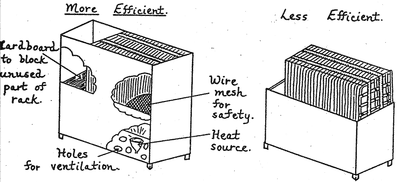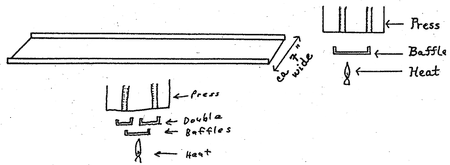Field Techniques Used by Missouri Botanical Garden
DRYING SYSTEMS
Warning
Fire is a constant danger. If the drying system is close to where you are sleeping or working, TAKE a smoke detector. It is best if the plants can be dried in a separate building or fireproof area. If not, extraneous flammable materials such as paper or alcohol should be kept out of the area.
Closely monitor presses and dryers if placed in or near private homes or field stations; fires do happen.
Types of Systems
There are basically two types of drying systems. The first is a convection system, which is easier and cheaper to build, and can use a wider variety of heat sources. The second is a forced-air system, which is more complicated and expensive to build but tends to be safer, and when properly designed is usually more efficient.
Convection System
In the convection system the plant presses are placed over a heat source. The warmed, dry air rises, passes through the channels in the corrugated cardboard, and carries the moisture away. A convection dryer can be made safer by putting screen, chicken wire, or mesh between the press and the heat source. Most fires start when the press loosens as it dries and pieces fall out onto the heat source. But also remember one must have easy access to the heat source to change bulbs, add fuel, clean out fragments and dust periodically, and for any other general maintainance proceedures. The press should never be put too close to the heat source. As the material in the press dries, it becomes more flammable and may ignite.
The heat source may be light bulbs, electric heating strips, kerosene stoves or lamps, propane, or any other source of heat. Propane is very readily available in most places and has been underused in the past. But note that at an elevation of over 2,000 m you may need an adjustable burner to compensate for the reduced oxygen content of the air. Note also that some types of kerosene stoves fluctuate too much to be used. Specimens can be dried by putting them over the back of a propane gas stove to enable the convection currents from the oven to dry the plants. One botanist had his plants dried over the oven of the local baker. Another collector who had only half a dozen specimens every few days dried them over the exhaust tube of a kerosene refrigerator! If you have a generator or other motor running constantly, always consider the possibility of devising some sort of arrangement for taking advantage of this waste heat.

The system is most efficient if both the heat source and the sides of the presses are enclosed by the walls of the drying rack. Block off any part of the rack that does not have a press on it. Heat should not escape except by going through the plant press.
Portable Convection Systems
People have made portable convection driers from numerous different materials. If you use canvas for the sides, fire resistant canvas, which is available in the U.S., is less of a hazard. Canvas has a tendency to be blown against the heat source and to ignite.
Botanists who are traveling cross-country with intermittent stops for collecting have tied their presses upright on the roof of the vehicle to let the presses air dry. This may not work with some aluminum corrugates. Sometimes it is possible to mount presses in front of a car radiator to take advantage of air movement when the vehicle is in motion, and radiated heat from the radiator when the vehicle has stopped (some botanists put canned food in the engine compartment to heat while driving, and stop for lunch without setting up the stove!).
Baffle System
If the heat is not evenly distributed in the dryer, an aluminum panel constructed above the heat source will allow better distribution. This aluminum baffle must either be well supported throughout its length or have the edges turned up to prevent it from sagging. A double baffle system distributes the heat still more evenly or allows a reduced distance between heat source and press.

Forced-air System
In the forced-air system the heat source is separate from the specimens and a fan is used to blow the air across the heat source and then through the presses. It is safer because the heat source does not have to be directly under the presses.
Catalytic Driers
Catalytic driers, which should be the safest, have been completely unusable in the tropics. The fuel has been unavailable or it has been so dirty that it ruined the catalyst immediately.
Oven Drying
Placing presses inside a closed oven is not feasible. Oven heat is often too moist and will encourage mold. The temperature cannot be satisfactorily regulated - if not dried long enough the plants will mold, if dried at too high a temperature, too fast or too long the plants will darken and crumble. Utilizing the warm air from the oven by placing the press above the open oven door may work.
Space Limitations within the Press
When press materials are the limiting factor, one may be able to dry a few more specimens by putting two thin specimens, such as thin grasses, Utricularia, small herbs, or small ferns, together between the blotters. If you use this method with thicker stems or fruits, it will result in shriveled leaves and unevenly pressed specimens. Also, if you double up too many specimens, even the thin sheets may not dry occupying the press materials for another day.
Space Limitations within the Dryer
If drying space is a problem, make a special effort to section thick fruits, stems, etc. It will speed drying. It will also result in fewer shriveled leaves and flatter specimens. A second layer of presses can be put over the first if they are separated by sticks layed lengthwise.
<< previous | main | next >>
| 




